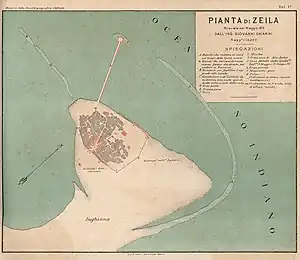Battle of Zeila
The Battle of Zeila was an armed encounter that took place in the city of Zeila, in modern-day Somaliland, between the forces of the Sultanate of Adal and those of the Portuguese empire, under the command of the governor of India Lopo Soares de Albergaria. After a brief fight, the Portuguese captured and razed the city.
| Battle of Zeila 1517 | |||||||
|---|---|---|---|---|---|---|---|
| Part of Portuguese Battles in the East | |||||||
 19th century map of Zeila | |||||||
| |||||||
| Belligerents | |||||||
|
| Adal Sultanate | ||||||
| Commanders and leaders | |||||||
|
| Unknown | ||||||
| Strength | |||||||
| 34 ships | Unknown | ||||||
| Casualties and losses | |||||||
| Few or none | Unknown | ||||||
The battle
In 1517, the Portuguese governor of India Lopo Soares de Albergaria sailed a large armada to attack Ottoman positions in the Red Sea. Having failed to capture Jeddah, short on water and supplies, the fleet withdrew, having called at Kamaran Island before sailing to Zeila. At the time the Sultanate of Adal was involved with most of its forces in a war with Ethiopia, a Portuguese ally, and the emir of Zeila Mahfuz had recently been killed.[1] Having been warned that the Portuguese fleet was incoming, the inhabitants evacuated all women and children, and a number of warriors remained behind to defend the city and the ships left behind. They gathered on the beaches to resist a Portuguese landing.[2] Seeing this, Albergaria determined to capture the city and landed a contingent of men.[2]
The Portuguese wrote that "The city is of good size and flat, by the edge of the sea. It's made of stone and lime houses with terraced roofs like those of Aden. Its inhabitants are moors and merchants of great trade and for the most part are black, men as well as children, and some white, and they treat each other well".[2]
Harassed by cannon-fire and taunted, the Portuguese under the command of Gaspar da Silva, Aires da Silva and António Ferreira Fogaça moved in to assault the city before the governor had landed, and when they realized there were few defenders they occupied it after a brief struggle.[2] A Portuguese prisoner which had been help captive in Zeila for nine years was rescued.[2] The city was then torched and destroyed.[3][2]
See also
References
- Francisco Álvares: "The Voyage of Sir Francis Alvarez, a Portugall Priest, made unto the Court of Prete Janni the great Christian Emperour of Ethiopia" in Samuel Purchas: Hakluytus Posthumus or Purchas his Pilgrimes, Volume 7, Cambridge University Press, p. 179.
- Fernão Lopes de Castanheda: Histório do Descobrimento e Conquista da Índia pelos Portugueses, 1833 edition, Typographia Rollandiana, book IV, chapter XIX pp. 39-41.
- Frederick Guest Tomlins: A complete system of geography, ancient and modern; comprising a full description of the world, physical, political, and historical ... Including the most recent discoveries, and the latest territorial arrangements., Halifax, 1845, p. 621.